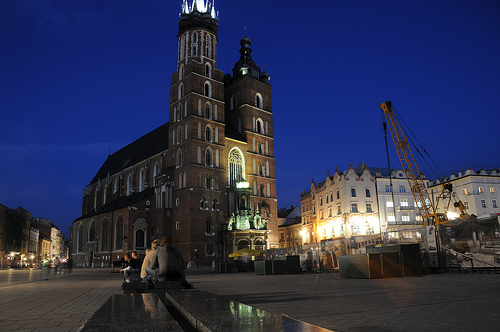The featured image is sourced from Flickr.
In the past few years, Kraków has become associated more with raucous parties and beer than with fun, culture, and romance. However, the old capital city of Poland is brimming with culture and flair, and absolutely worth a sober visit.
Kraków is a stronghold of Polish tradition (yes, including the beer) and history. The city started as a hamlet on the same hill which now holds Wawel Cathedral and castle. A climb up Wawel Hill makes for a fantastic day trip. The cathedral’s gold-covered walls are an impressive sight, as is the castle’s exhibition of its sixteenth century royal quarters. Wawel Hill presents an eclectic mix of building styles fascinating to any amateur historians and architects. An alleged dragon’s den under the castle walls is subject to a plethora of local myths and legends. The city itself is surrounded by a defensive wall, representing one of the most strategically advanced defensive architecture of the time. Another popular historical day trip option is a trip to the Wieliczka salt mine – one of the oldest salt mines in the world.
For those wanting to drink in the local atmosphere after a historic day out, Kraków provides a thriving jazz and live music culture, and most of its bars have bands playing every night. An insider’s tip is the underground bar Pod baranami just off the main market square. Originally a meeting point for those resisting the Nazi occupation and later Communist regime, its decor still evokes these very recent events in Polish history. The cocktails and music are also excellent. For those after some traditional Polish food, the pub-style restaurant called Chlopskie Jadlo can be highly recommended – it is located in the old town, between Wawel Hill and the main market square.
Kraków has always been a melting pot for different cultures. Jewish, Oriental, and European influences are evident in architecture, food, and the avid local culture of market haggling. The old Jewish quarter (Kazimierz) with its synagogues is located back to back with some of Eastern Europe’s most famous Christian churches, such as the Church of St. Mary, which rises over the northeast corner of the main square. Kraków also is on the River Vistula, and there are regular cruises up and down the river, which will allow you sit back, relax, and enjoy the view. Furthermore, there are a considerable number of travellers who opt to take a cruise excursion to Krakow when their cruise ship stops in Gdansk, bringing new faces and visitors to Krakow. Cruise lines are almost always a good source of tourists for cities regardless of where they are situated.
The music and art scenes in Kraków are arguably the most important and creative ones in Poland. The National Gallery holds a variety of paintings with an emphasis on fifteenth and sixteenth century Polish Renaissance art – the time of the Polish ‘Golden Age’. A variety of smaller private galleries hold contemporary art. The Kraków Philharmonic orchestra is only one of the many concert options available. Particularly popular are the open air concerts and operas held in the city’s green belt (the ‘Planty’) and the Jagiellonian University gardens. Concerts are available every night across the city, and are usually held in one of the city’s many churches. Particularly atmospheric are string quartet performances in the little round church north of St. Mary’s; flyers for these concerts are usually given out on the market square during the day.
Last but not least, shopping opportunities in Kraków are excellent. The city’s specialties are leather works (anything from fine gloves, to shoes, to bags) and amber jewelry. There are global shops as well as local shops aplenty, and the weekly Saturday market holds some real clothing and leather bargains.

